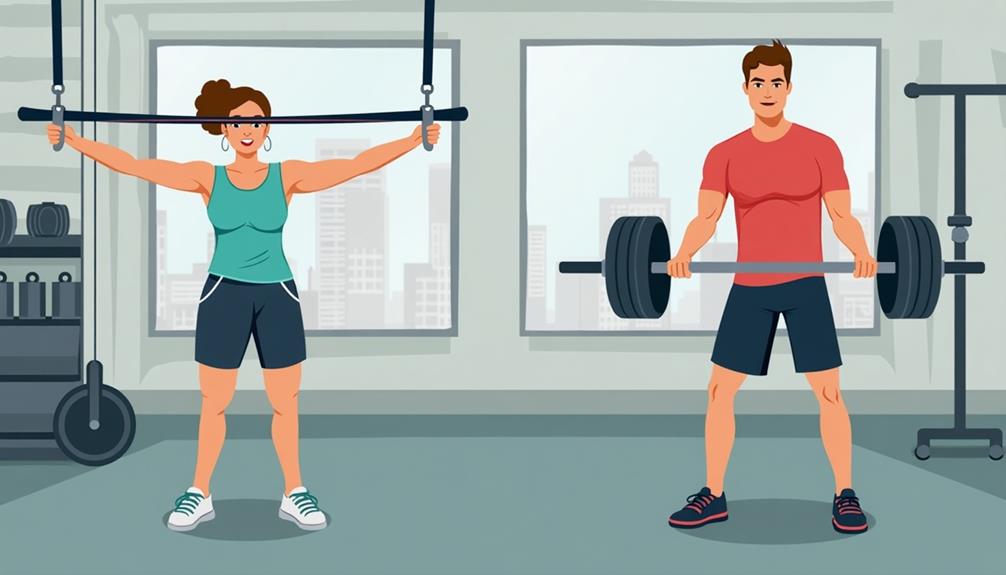Accommodating resistance training helps you enhance strength and power by adjusting resistance throughout your range of motion. By using bands or chains during weightlifting, the resistance increases at specific points in the lift, promoting better muscle activation. This method allows for a more natural movement pattern and reduces the risk of injury. You'll also benefit from customizable resistance levels that adapt to your training needs. As you implement this technique, focus on maintaining control during each movement. Keep exploring further, and you'll discover even more tips to optimize your training experience.
Core Insights
- Accommodating resistance uses bands or chains to adjust resistance levels throughout the range of motion during weightlifting.
- This method increases resistance at specific points, promoting better muscle activation and enhancing strength and power.
- It creates variable load, allowing muscles to work harder at peak strength and providing a natural movement pattern.
- Incorporating accommodating resistance reduces the risk of injury while adding variety to workout routines.
- Gradually increasing resistance and focusing on control during movements optimizes training effectiveness.
What Is Accommodating Resistance?

Accommodating resistance is a training method designed to enhance strength and power by adjusting the resistance level throughout the range of motion. This technique often involves using equipment like bands or chains during weightlifting. As you lift, the resistance increases at specific points, allowing you to exert more force when your muscles are strongest. This adaptation helps improve your strength and power more effectively than traditional methods. Similar to TRX systems, accommodating resistance offers versatility and can be integrated into various workout routines. You'll notice that your body engages differently throughout the lift, promoting better muscle activation. It also reduces the risk of injury by allowing for a smoother shift between weak and strong phases. Overall, accommodating resistance can be an effective addition to your training regimen, optimizing your performance and results.
The Science Behind Resistance Training

Resistance training is grounded in a solid understanding of how muscles adapt to stress. When you lift weights or use resistance bands, your muscles experience micro-tears. Your body responds by repairing these tears, making the muscles stronger and more resilient. This process is called muscle hypertrophy.
Here's a simple breakdown of key concepts:
| Concept | Explanation |
|---|---|
| Muscle Tension | The force generated when muscles contract |
| Muscle Damage | Micro-tears that occur during intense workouts |
| Metabolic Stress | The buildup of metabolites during exercise |
| Recovery and Adaptation | The process of repairing and strengthening muscles |
Understanding these principles helps you optimize your resistance training. By manipulating variables like weight and volume, you can consistently challenge your muscles, promoting growth and strength.
Benefits of Accommodating Resistance

Second, it enhances power development. By training explosively against bands or chains, you'll improve your speed and force production, beneficial for athletes in any sport. This method also allows for customizable resistance levels, making it suitable for various fitness goals from rehabilitation to advanced strength training.
Additionally, accommodating resistance reduces the risk of injury. It allows for a more natural movement pattern, minimizing stress on your joints.
Lastly, it adds variety to your routine. Changing your training stimulus keeps workouts fresh and engaging, which can boost motivation. Overall, accommodating resistance is a smart addition to elevate your training.
How to Implement Bands and Chains

To get the most out of bands and chains, start by understanding how to effectively integrate them into your workouts. Begin with the basics: choose the right resistance level. Bands come in various thicknesses, while chains offer different weights. Next, secure the bands or chains to your barbell or equipment. For bands, loop them around the bar and anchor them to the ground or a sturdy object. For chains, drape them over the bar, ensuring they rest on the floor at the start of your lift. When selecting your equipment, consider user-friendly designs that allow for easy adjustments and comfortable use during your workout sessions.
When you lift, focus on maintaining control throughout the movement. Aim for a steady pace, especially during the eccentric phase. Finally, gradually increase resistance as you become comfortable, ensuring continuous progress and adaptation.
Training Techniques for Maximum Effectiveness

Maximizing the effectiveness of your training requires a strategic approach that goes beyond simply adding bands and chains. To truly harness the power of accommodating resistance, consider these techniques:
| Technique | Purpose | Example |
|---|---|---|
| Variable Load | Adapt resistance throughout the lift | Use bands to increase tension at peak strength |
| Tempo Training | Control the speed of each rep | Slow down the eccentric phase for muscle activation |
| Range of Motion | Challenge different angles | Incorporate partial reps at sticking points |
Comparing to Traditional Weightlifting

The evolution of resistance training has led to a powerful shift from traditional weightlifting to accommodating resistance methods. While traditional weightlifting focuses on lifting fixed weights, accommodating resistance adapts to your strength curve. This means you can exert more force at different points in the movement, enhancing muscle engagement.
In traditional weightlifting, your muscles face constant resistance, which may limit growth potential. With accommodating resistance, you can target muscle weaknesses more effectively, improving overall strength. Additionally, this method often reduces the risk of injury, as it allows for a more natural range of motion.
Ultimately, accommodating resistance offers a dynamic and adaptable approach, making it a valuable addition to your training regimen. It's time to explore how these methods can elevate your workout experience.
Common Mistakes to Avoid

When incorporating accommodating resistance into your training, it's easy to make mistakes that can hinder your progress. One common error is neglecting proper form. With added resistance, your technique can suffer, leading to injuries. Always prioritize your form over the weight you're lifting.
Another mistake is using excessive resistance. If the load is too heavy, you might struggle to complete your reps, which defeats the purpose of accommodating resistance. Start with lighter weights and gradually increase as you become more comfortable.
Tips for Progress Tracking

Effective progress tracking is crucial for anyone using accommodating resistance in their training regimen. By monitoring your progress, you can make informed adjustments and stay motivated. Here are some tips to help you track your progress effectively:
- Keep a Training Journal: Document your workouts, including exercises, sets, reps, and resistance levels. This helps you visualize improvements over time.
- Set Specific Goals: Establish clear, measurable goals for your training. This gives you something concrete to work towards.
- Take Regular Measurements: Measure your strength, body composition, or performance metrics at set intervals to see tangible changes.
- Review and Adjust: Periodically assess your progress and tweak your training plan as necessary to maintain continuous improvement.
Frequently Asked Questions
Can Accommodating Resistance Training Be Used for Rehabilitation Purposes?
Yes, you can definitely use accommodating resistance training for rehabilitation. It helps improve strength while accommodating your current abilities, allowing for a safer and more effective recovery process tailored to your specific needs and goals.
How Does Accommodating Resistance Affect Muscle Fiber Recruitment?
Accommodating resistance amplifies activation, ensuring every muscle fiber fires effectively. By adjusting load throughout your lift, you'll maximize muscle recruitment, enhancing strength and stability. This dynamic approach keeps your workouts challenging and engaging, driving impressive results.
Is Accommodating Resistance Suitable for Beginners?
Yes, accommodating resistance can be suitable for beginners. It helps you build strength safely by adjusting resistance to your capability, enhancing your form and control, while promoting muscle engagement without overwhelming your body right away.
What Equipment Is Needed Beyond Bands and Chains?
Beyond bands and chains, you'll need a power rack for safety, adjustable dumbbells for versatility, and a barbell for heavier lifts. These tools enhance your training, allowing for varied resistance and increased strength development.
How Can I Measure My Progress With Accommodating Resistance?
You can measure your progress by tracking the weights lifted, reps completed, and how your form improves over time. Regularly recording your performance helps you notice trends and make necessary adjustments to your training.

